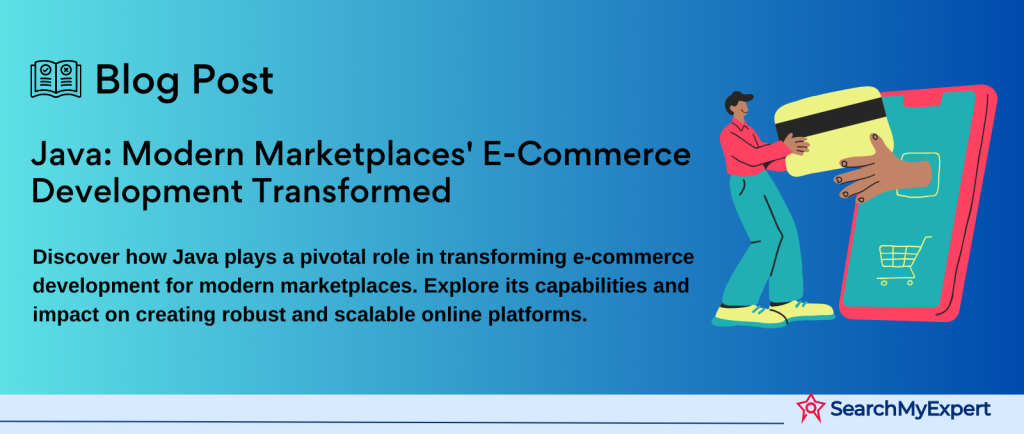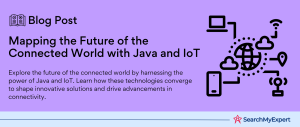Java Web Development for E-commerce: Harnessing the Power of Java for Online Success
The Dawn of E-commerce: A Brief History
E-commerce, a revolution in shopping, transformed from mail-order catalogs to digital storefronts. The 1990s saw the dawn of online shopping, igniting a global marketplace. Today, it’s a bustling, dynamic industry, shaping how we buy and sell.
Java: The Backbone of E-commerce Development
Why Java for e-commerce? Think stability, scalability, and top-notch security. It’s a powerhouse, a steadfast choice for developers. Picture a robust ecosystem, brimming with tools and libraries, tailor-made for crafting seamless e-commerce experiences.
The Core Benefits of Java in E-commerce Web Development
Java isn’t just a language; it’s a gateway to performance, flexibility, and a vast developer community. It offers:
- Stellar Performance:
Java’s speed and efficiency make it ideal for handling the complex needs of e-commerce platforms. - Unmatched Flexibility: Adapt and evolve with Java. Its versatility means your e-commerce platform can grow and change, hassle-free.
- Developer Availability: A huge community of Java developers is at your fingertips, ready to innovate and elevate your e-commerce experience.
In this digital era, Java stands as a beacon of reliability for e-commerce platforms, driving growth and pushing boundaries. Let’s embark on this journey to understand how Java powers the e-commerce world.
Understanding the Architecture
Model-View-Controller (MVC): The Blueprint for E-commerce Success
The MVC architecture, a design blueprint, is vital in e-commerce applications. It segments an application into three interconnected components:
- Model: The heart of the application, where data lives. Think products, prices, user profiles.
- View: The face of the app. It’s what users see and interact with – product pages, shopping carts.
- Controller: The brain, processing user input and interacting with the Model to render the final View.
Separation of Concerns: A Pillar of Maintainability and Extensibility
This architectural style brings a clear separation of concerns – a division that offers significant benefits:
- Easier Maintenance:
With distinct roles, identifying and fixing issues becomes streamlined. - Enhanced Extensibility:
Want to upgrade or extend your platform? MVC makes it simpler, with less risk of ripple effects.
Java’s MVC Champions in E-commerce: Spring, Spring Boot, JSF
Java boasts a rich selection of frameworks for MVC implementation:
- Spring:
A heavyweight in the Java world, known for its robust ecosystem. - Spring Boot:
Spring’s younger sibling, it simplifies development with convention over configuration. - JSF (JavaServer Faces):
A framework focusing on server-side user interfaces, making UI development a breeze.
These frameworks are the unsung heroes behind many successful e-commerce platforms, empowering them with agility, robustness, and scalability.
Building the Front-End
The Trio of Web Development: HTML, CSS, and JavaScript
In Java web development, the front-end magic begins with HTML, CSS, and JavaScript. They’re the building blocks of e-commerce UI/UX:
- HTML:
The skeleton. It lays out the structure – product listings, navigation bars. - CSS:
The artist. It adds style, from colors to layouts, making the interface appealing. - JavaScript:
The wizard. It brings interactivity, enabling dynamic content and user engagement.
Frontend Frameworks: React and Angular in the Spotlight
Enter React and Angular – two titans in frontend development:
- React:
A library by Facebook, famous for its virtual DOM, boosting performance and user experience. - Angular:
A full-fledged framework by Google, offering a comprehensive solution for building dynamic web apps.
These technologies work in tandem with Java back-ends to create responsive, interactive e-commerce platforms that not only look good but feel intuitive to use.
Responsive Design: One Size Fits All
The key to winning the e-commerce race? Responsive design. It ensures your website looks great and functions smoothly across all devices – smartphones, tablets, laptops. Mobile optimization is not just a feature; it’s a necessity in today’s mobile-first world.
Developing the Back-End
Java Servlets and JSPs: The Server-Side Maestros
In the realm of Java e-commerce development, servlets and JavaServer Pages (JSPs) play pivotal roles. They’re the workhorses behind server-side processing and data manipulation:
- Java Servlets:
Think of them as gatekeepers, handling client requests and server responses. - JSPs: They’re the storytellers, dynamically creating web pages based on user interactions.
Database Connectivity: JDBC and JPA
Managing data is key in e-commerce. Here’s where JDBC and frameworks like JPA shine:
- JDBC (Java Database Connectivity): It’s the bridge between Java applications and databases, ensuring smooth data flow.
- JPA (Java Persistence API):
A higher-level framework that simplifies data persistence and ORM (Object-Relational Mapping).
These tools help manage vast product catalogs, customer data, and transaction records efficiently and effectively.
Security: The Bedrock of Trust
In e-commerce, security isn’t just a feature; it’s a foundation:
- User Authentication and Authorization: They’re like bouncers, ensuring only authorized users access specific data and functionalities.
- Data Encryption: It’s the vault of e-commerce, safeguarding sensitive data like user credentials and payment information.
Java’s security mechanisms are robust, offering peace of mind for both developers and users in the ever-evolving landscape of e-commerce.
Payment Processing and Integration
Secure Payment Gateways and APIs: The Heart of Transactions
In Java-based e-commerce, integrating secure payment gateways is crucial. It’s all about smooth, reliable transactions:
- Secure Gateways: They act like virtual cash registers, efficiently handling payments.
- APIs: The glue that connects e-commerce platforms with payment services, ensuring seamless transactions.
Fraud Prevention and Chargeback Management: The Shields of E-commerce
Staying vigilant is key:
- Fraud Prevention:
Tools and practices are in place to detect and prevent fraudulent activities. - Chargeback Management: Strategies to handle disputes and chargebacks, maintaining customer trust and financial integrity.
Going Global: Multicurrency and International Payments
E-commerce knows no borders. Java platforms often include:
- Multicurrency Support:
Allowing customers to pay in their local currency. - International Payment Options:
Catering to global audiences with diverse payment preferences.
In the vast world of e-commerce, Java stands as a trusted ally, ensuring transactions are not just seamless but also secure and globally accessible.
Deployment and Maintenance
Deployment Options: Versatility in Java E-commerce
Java’s flexibility shines in deployment:
- On-Premise Servers: For full control, on-premise solutions are a go-to.
- Cloud Platforms:
Think AWS, Azure. They offer scalability and robustness. - PaaS Solutions:
Platforms like Heroku and Google App Engine simplify deployment, focusing on your application, not the infrastructure.
Monitoring and Logging: The Pulse of Your Platform
Keep your finger on the pulse:
- Performance Optimization: Tools and practices for monitoring ensure your site runs smoothly.
- Error Detection:
Logging mechanisms are vital for quickly identifying and rectifying issues.
Version Control and CI/CD: The Backbone of Agile Development
Stay agile and efficient:
- Version Control: Solutions like Git keep track of every change, every version.
- CI/CD Practices: Continuous Integration and Continuous Delivery ensure that new code is tested and deployed efficiently.
In the dynamic world of e-commerce, deployment and maintenance are not just about keeping the lights on. They’re about innovation, efficiency, and constant evolution.
The Java Advantage in E-commerce
Java: A Stalwart in E-commerce Development
Java’s journey in e-commerce is marked by:
- Stability: It’s tried, tested, and trusted.
- Scalability: From startups to giants, Java grows with your business.
- Security:
A fortress, guarding against cyber threats. - Robust Ecosystem:
A treasure trove of libraries, frameworks, and community support.
The Future: Java in the E-commerce Landscape
Java’s future looks bright:
- Emerging Trends:
IoT, AI integration, and more. - Market Growth: Java continues to adapt, staying relevant and powerful.
Resources and Recommendations: Keep Learning
Eager to dive deeper? Explore:
- Online courses, webinars, and tutorials.
- Vibrant community forums and expert blogs.
- Books and guides for every skill level.
Java in e-commerce is not just about coding; it’s about building a future-proof, dynamic online presence.
Conclusion
Java’s pivotal role in e-commerce development is marked by its robustness, versatility, and security. Excelling in back-end and front-end development, Java ensures scalable, efficient, and user-friendly e-commerce platforms. Its adaptability with emerging technologies like AI and IoT, along with a strong community and rich resources, makes it a future-ready choice. Java is not just a programming language; it’s a gateway to creating dynamic, resilient, and successful online marketplaces. For developers and businesses alike, Java in e-commerce represents a blend of reliability, innovation, and growth, making it an indispensable tool in the digital commerce landscape.
Empower your software development with Java Development Service Companies.
Table of Contents
Toggle






